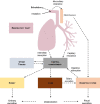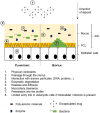Enhancement of lung gene delivery after aerosol: a new strategy using non-viral complexes with antibacterial properties
- PMID: 29046368
- PMCID: PMC5691145
- DOI: 10.1042/BSR20160618
Enhancement of lung gene delivery after aerosol: a new strategy using non-viral complexes with antibacterial properties
Abstract
The pathophysiology of obstructive pulmonary diseases, such as cystic fibrosis (CF), leads to the development of chronic infections in the respiratory tract. Thus, the symptomatic management of the disease requires, in particular, repetitive antibiotherapy. Besides these antibacterial treatments, certain pathologies, such as CF or chronic obstructive pulmonary disease (COPD), require the intake of many drugs. This simultaneous absorption may lead to undesirable drug interactions. For example, Orkambi® (lumacaftor/Ivacaftor, Vertex), a pharmacological drug employed to treat F508del patients, cannot be used with antibiotics such as rifampicin or rifabutin (rifamycin family) which are necessary to treat Mycobacteriaceae. As far as gene therapy is concerned, bacteria and/or biofilm in the airways present an additional barrier for gene transfer. Thus, aerosol administration of nanoparticles have to overcome many obstacles before allowing cellular penetration of therapeutic compounds. This review focusses on the development of aerosol formulations adapted to the respiratory tract and its multiple barriers. Then, formulations that are currently used in clinical applications are summarized depending on the active molecule delivered. Finally, we focus on new therapeutic approaches to reduce possible drug interactions by transferring the antibacterial activity to the nanocarrier while ensuring the transfection efficiency.
Keywords: Aerosol; Antibacterial properties; Gene delivery; Lung diseases; Nano carriers; multimodal therapy.
© 2017 The Author(s).
Conflict of interest statement
The authors declare that there are no competing interests associated with the manuscript.
Figures





References
-
- Ibraheem D., Elaissari A. and Fessi H. (2014) Gene therapy and DNA delivery systems. Int. J. Pharm. 459, 70–83 - PubMed
-
- Yin H., Kanasty R.L., Eltoukhy A.A., Vegas A.J., Dorkin J.R. and Anderson D.G. (2014) Non-viral vectors for gene-based therapy. Nat. Rev. Genet. 15, 541–555 - PubMed
-
- Mintzer M.A. and Simanek E.E. (2009) Nonviral vectors for gene delivery. Chem. Rev. 109, 259–302 - PubMed
-
- Li L., Wei Y. and Gong C. (2015) Polymeric nanocarriers for non-viral gene delivery. J. Biomed. Nanotechnol. 11, 739–770 - PubMed
Publication types
MeSH terms
Substances
LinkOut - more resources
Full Text Sources
Other Literature Sources
Medical
Research Materials

